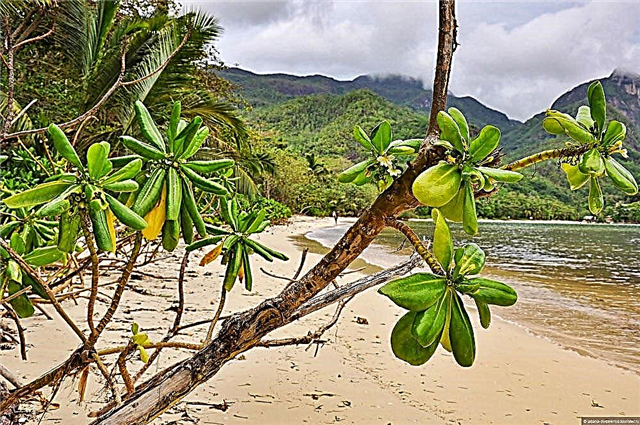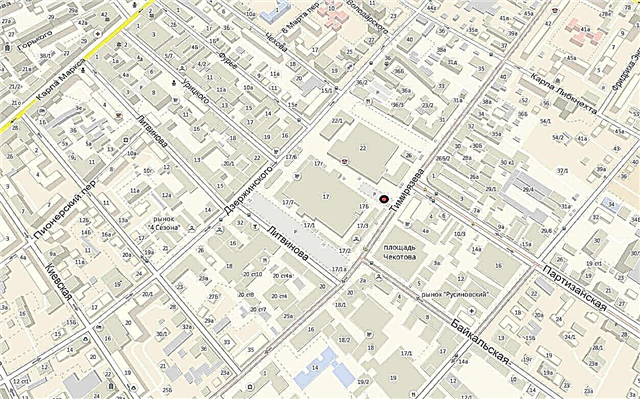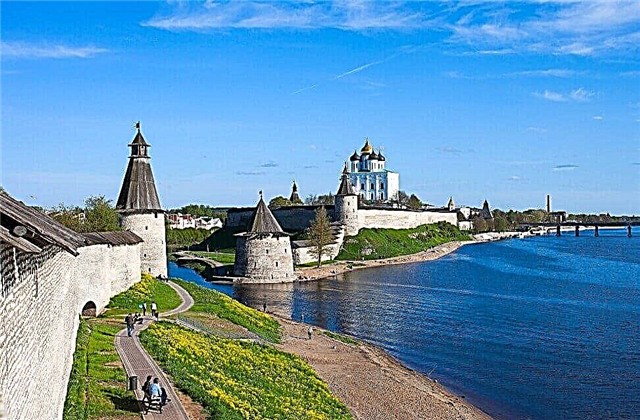The Pskov region is one of the centers of ancient architecture. The geographical position and constant encroachments on the Russian lands made this area a concentration of defensive structures. That is how fortresses appeared, performing a variety of functions. Many, for example, Porkhovskaya or Izborskaya, have survived to this day. A separate line worth highlighting is the Mikhailovskoye Estate Museum - not only one of the best Pushkin museums in the world, but also a picturesque reserve. The neighboring manor and noble houses are the imprint of an entire era. There are enough interesting things in the region for pilgrims, the Pskov-Pechersky Monastery alone is worth the time spent on the trip. There are other notable places where tourists will definitely not be bored.
The most interesting and beautiful places in the region
List, photos with names and descriptions of popular attractions of the Pskov region!
Pskov Kremlin
Built at the end of the XI-beginning of the XII century. It stands on the banks of the Velikaya River. The ensemble includes: Trinity Cathedral, Prikaznye chambers, towers and others. Dovmont town is an important part of the architectural complex. It appeared later and was added for additional protection of the city, walls of a new level were built. Excavations and restoration work have been carried out on its territory. The foundations of the temples and part of the wall paintings have been preserved.

Pskov-Pechersky Monastery
Male. Built in 1473. The name comes from the caves located on its territory, called "Created by God". The caves are divided into near and far, the latter - among other things, the monastery cemetery. It is also notable for the fact that it has never been closed. Shrines - the miraculous icon of the Dormition of the Mother of God, lists of other valuable icons, the relics of the saints. The fortress walls have their own peculiarities, and there are holy springs nearby.

Museum-Estate "Mikhailovskoye"
Reserve dedicated to Pushkin. Founded in 1911. It includes natural beauties such as lakes, as well as objects associated with the writer. He was here as a child and lived in exile. The excursion includes a visit to the family estate of the poet, his grave, a mill museum, "Pushkin village", estates in the neighborhood, etc. The program is extensive, since the territory of the complex is almost 10 thousand hectares.

Museum-estate "Petrovskoe"
Opened in 1977. Connected with the history of the ancestors of Pushkin - the genus of Hannibals. These lands were owned by the writer's great-grandfather since 1742. The exposition is mostly dedicated to him and his son. The complex includes not only the house and the garden, but also the memorial park, which houses the Grotto-gazebo. Thanks to the architectural work carried out, the estate looks untouched by time.

Museum-estate "Trigorskoe"
Founded in 1962. It once belonged to the Osipov-Wulfs - the landowners and friends of Pushkin. It is part of the Pushkin Reserve. The manor house has been rebuilt from scratch, as the original manor house burned down in 1918. Nearby there is a park - an example of Russian gardening art of the 18th century, as well as a family cemetery of the original owners. Some of them are considered prototypes of Pushkin's heroes.

Porkhovskaya fortress
Built in 1387. Located in the center of the city of the same name. The general ensemble has been preserved, although in some places the state is close to emergency. Was built, among other stone checkpoints to strengthen the trade route. Has three towers. During its existence, it experienced a siege and a period of decline. In the fortress there are museums of local post office and museum of local lore, as well as the St. Nicholas Church.

Izborsk fortress
Built at the beginning of the XIV century. An ancient city was subsequently formed around. It had a defensive value and was repeatedly used for its intended purpose. The fortress was strengthened and rebuilt several times. Now in the process of recovery. The restoration especially concerns the towers and the fortress wall. Nikolsky Cathedral and the battle course have already been brought into a historically accurate form.

Slovenian keys in Izborsk
In the vicinity of the city there have always been many underground springs and springs, known since ancient times. Slovenian is the most famous of all. Groundwater flows to the surface between carbonate rocks. They split into a dozen strings, sometimes more, and fall down noisily, so that they look like a cascade of low waterfalls. The water is filtered naturally, so it is very clean.

Lake Peipsi
Located on the territory of Russia and Estonia. Unleavened. The area is more than 2.5 thousand km². The fifth largest among European. The average depth is 7.5 m. The main historical event associated with the lake is the Battle of the Ice in 1242. Many rivers flow in, only Narva flows out. Tourist ferries are constantly supervised. There are sandy beaches with a smooth entrance into the water. On the Russian coast is the city of Gdov.

Svyatogorsk monastery
Male. Founded in 1569. It is located in the Pushkin Hills. The main shrine is the icon of the Mother of God Hodegetria, a legend is connected with its acquisition. The original purpose of the monastery was an outpost. Gradually, the monastery expanded and received new functions, including being used as a venue for fairs. Here is the grave of Pushkin. The territory is part of the writer's museum-reserve.

Sebezh National Park
Founded in 1996. Located in the area of the same name. The area is over 50 thousand hectares. The structure includes land funds, rivers, forests, lakes and more. In addition to preserving nature and rare species, this area has a tourist destination. Ozeryavki is a recreation center with a bathhouse, sports grounds, entertainment for children and the Fisherman's House. There are other stopover options, including camping sites.

Truvorovo settlement
Located near Izborsk. Dated to the 7th-18th centuries. There is a six-meter protective shaft and a moat up to three meters deep. The area includes the Church of St. Nicholas. Nearby is an ancient cemetery. One of the crosses especially stands out for its dimensions; its installation is associated with the history of the Varangian Truvor. In the early 70s of the last century, excavations were carried out, a boundary stone with inscriptions in Cyrillic was found.

Chain bridges over the arms of the Velikaya river
Built in the early 50s of the XIX century. The length is 93 meters. Initially, one bridge was conceived as a pedestrian, the second, as suitable for transport. The original design has undergone changes as the flood period was not taken into account. During the war, the bridges were damaged, but after a year they were restored. The chains are protected from vehicle cutting and other possible accidents by special barriers.

Thunder tower
Built in 1525. Its original purpose was the fortification of the Okolny town. Refers to the Pskov Fortress. Stands on the bank of the river. The base diameter is about 15 meters, and the height is about 30 meters. The rock is part of the floor and walls of the tower. Under the structure there is a system of underground passages, including a manhole to the water, which was of importance during the siege. Well preserved, but in some places there is minor damage.

The Menshikov chambers in Pskov
They are located on Romanov Gorka. Previously, they belonged to a family of merchants. They were badly damaged in a fire in 1710. The former owners became poorer and sold the building. The ceilings of the third floor were restored, as well as the external decoration. It is a monument of architectural architecture. They now house a gift and flower shop. Booklets with the history of the chambers can be purchased.

Velikie Luki fortress
Located in the city of the same name. It also has another name - Bastion. Built at the very beginning of the 18th century. At this place, defensive institutions existed before. The new design was erected by order of Peter I. It was multifunctional and more robust.There were two entrances through stone gates in the north and west of the fortress. There were many outbuildings and a cathedral inside. There are excursions now.

Krypetsky Monastery
Male. Founded in 1485. The Athos monk Savva Krypetsky stood at the source. After the revolution it was closed, many values disappeared without a trace. Since 1960 it has been a monument of republican significance. Since the return of the ROC, restoration has been carried out, a new church has been built. There is a holy spring, a bathhouse has been built. Two dozen female novices live at the monastery on a permanent basis.

Museum-reserve M.P. Mussorgsky
Located in the village of Naumovo. Founded in 1970. The only one in the world. Occupies the house of the Mussorgsky family, where his mother was born. The museum's expositions are associated with both the biography of the composer and the peasant life of the 19th century. The original interior has been preserved inside. There is a park around. The complex also includes: a greenhouse, an outbuilding, a barn and more. Nearby Жizhitskoe lake.

Museum-Reserve of N.A.Rimsky-Korsakov
Located in the Plyussky district. Founded in 1995. The museum occupies two estates that belonged to Rimsky-Korsakov. In Lyubensk he wrote The Golden Cockerel, in Vechash - The Tale of Tsar Saltan, Sadko and many other operas. Houses and parks were destroyed during the Second World War and restored according to the available images and drawings. The exposition consists of two exhibitions: "nature in the work of the composer" and "the last years of life and work".

Museum-Estate of S. Kovalevskaya
Opened since 1986. The exposition is housed in an estate that once belonged to the father of the first female mathematician in our country. Kovalevskaya spent her childhood and youth in this house. The collection consists of the researcher's personal belongings, her diaries, and work records. The main goal of the exhibition is to show Sophia as a versatile person. The foundation has been moved to the wing, as the main building is undergoing restoration.

Polistovsky Reserve
Founded in 1994. The area exceeds 37 thousand hectares. The lakes are located in groups. They are inhabited by all kinds of inhabitants, only there are more than 50 species of crustaceans. The vast lands are covered with swamps. The relief is changeable, and the temperature is rather cool: the average annual does not exceed +5 ° C. Almost half of the territory is under special protection. You cannot get here without a pass - the reserve has a strict status.

Mirozhsky monastery
Male. First mentioned in 1156. Located in Pskov. Since it was built outside the city walls, it was often attacked. The preserved ancient frescoes of the cathedral church are of particular value. After returning to the ROC, the local school of icon painting was first illuminated. Attraction nearby - Pskov Kremlin. It stands at the confluence of two rivers, periodically partially flooded.

Basil the Great Church on Gorka
First mentioned in 1337. White stone walls look uneven, forming tiers. It has two aisles and three apses. The main dome rises significantly above the structure, which is an architectural feature. Dark domes are another atypical detail. Therefore, the church not only attracts pilgrims, but is also interesting for connoisseurs of architecture.

Gdovsk Kremlin
It is mentioned for the first time in the XIV century. Located in the city of the same name. The original fortifications on this site were earthen. The embankments were replaced with stone walls, and then the towers were erected. Throughout its history, the Kremlin has repeatedly withstood attacks, ruined and even partially destroyed, but was rebuilt again. During the Second World War, a cathedral located on the territory of the Kremlin was blown up. It was rebuilt in the 90s of the last century.

Nikandrova hermitage
Monastery for men. Founded in 1585. It is located in the Porkhovsky district. The construction of the monastery is connected with the legend about the Monk Nikandra, who spent 50 years in prayer. Initially, the buildings were mostly wooden. Fires and general dilapidation forced the use of stone in construction. After restoration, a new cathedral was built in 2010. There are holy springs on the territory.

Spaso-Kazan Simansky monastery
Female. Founded in 1897. Located in the city of Ostrov. At the monastery there were schools for girls and all kinds of small workshops, as well as a hospital where a "sobriety society" existed. The closure during the period of the USSR was briefly interrupted during the war years. However, then the monastery again fell into disrepair. A new life began here in 2003. One of the shrines is a list of the Kazan Icon of the Mother of God.

Museum-Estate of the Seto People
Occupies a premise that used to be the ancestral home of the Külaots family. This nationality has its own language, traditions, folklore, clothing. They converted to Christianity, but only partially abandoned ancient beliefs, so in terms of rituals, Seto got it all mixed up. There is a private museum of nationalities nearby, which complements the overall picture. It works only during the warm season.

Trutnevskaya cave
Located near Lake Peipsi. The village shrine is revered by the locals and attracts tourists. The procession stops here, and special celebrations are held on Friday 6th. Priests from nearby temples hold prayers in a cave. A special value is “a stone with a trace of the Mother of God”. Those who do not believe in the legend are also interested in the natural phenomenon.

Olginskaya chapel
Located in Pskov. Construction ended in 2000. The annals mention that Orthodox shrines existed at this place before, but they were lost. Location - observation deck on the river. The architecture is based on the Greek cross. The structure is small in size, laconic and neat. The facades are decorated with slabs with text. There is a hatch in the floor for access to a water source.

Balloon Festival in Velikiye Luki
It takes place annually in early June and lasts for a week. Balloons of different colors are constantly rising into the sky. Both professionals in this type of leisure and those who want to climb under the clouds for the first time come here. In addition to chaotic launches, various mini-competitions and show programs are held.












